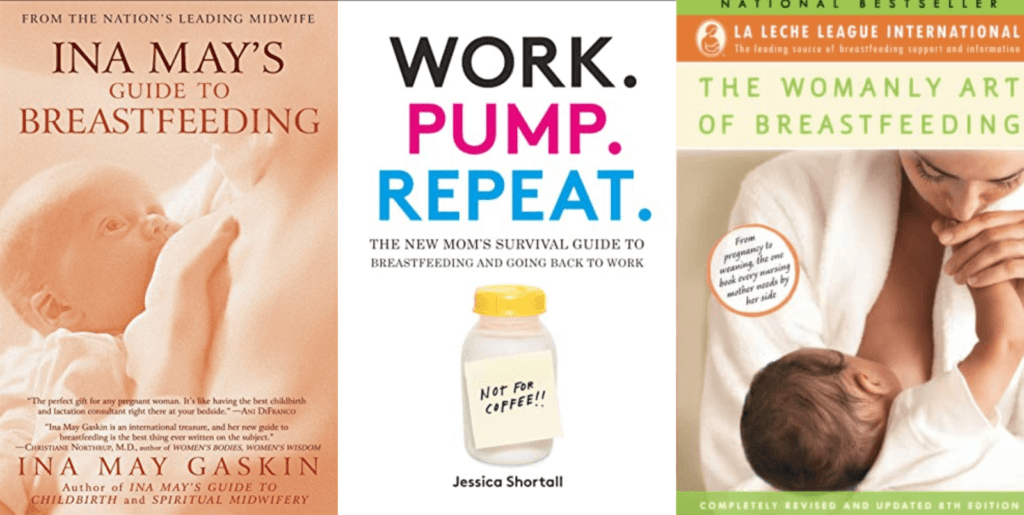This post contains some of the best breast pumping tips for new moms.
How Pumping Works
Pumping is a way for breastfeeding mothers to provide their baby with breast milk when they are not able to breastfeed directly.
Some mothers choose to pump their milk because they have to go back to work or school or simply want to share the feeding duties with their partner or caregiver.
It’s important to follow proper hygiene and storage guidelines when using a breast pump to ensure that the milk remains safe and fresh for your baby to consume.
Here’s how pumping works:
1. Wash Your Hands And Your Breast Pump Parts: Before you start pumping, make sure you wash your hands and your breast pump parts with soap and warm water.
2. Find A Comfortable Place To Pump: Sit in a comfortable chair or recline on a couch with back support. Make sure you have access to an outlet if you’re using an electric pump.
3. Stimulate Let-Down Start by stimulating let-down by placing a warm compress on your breast or massaging your breast for a few minutes.
Let-down is a natural reflex where the mother’s body releases milk from the breast. This occurs when the baby latches onto the breast and begins to suckle.
The milk ducts in the breast are stimulated, and the hormone oxytocin is released, causing the muscles around the milk ducts to contract and push the milk out of the nipple. This process is also known as the milk ejection reflex.
Let-down usually occurs between one and three minutes after the start of breastfeeding, and may feel like a tingling or warm sensation in the breast.
4. Position The Breast Shield: Next, position the breast shield (the part that goes over your nipple) on your breast so that your nipple is centered in the middle of the shield.
5. Pump: Turn on the breast pump and let it do its job. It’s important to start with a low suction level and gradually increase it until you find a comfortable level.
6. Switch Sides: Once milk flow slows down, switch to the other breast and repeat.
7. Store Breast Milk: Once you’ve finished pumping, store your breast milk in a clean, sterile container in the refrigerator or freezer.
Remember, it’s important to clean your breast pump parts after each use to prevent contamination and to make sure your breast milk stays safe for your baby.
Related: How To Combine Breastfeeding And Pumping?
Benefits of Pumping
There are several benefits of pumping breast milk. Here are some of them:
1. Increases milk supply: Pumping stimulates milk production and helps increase the amount of breast milk a mother can produce.
2. Provides flexibility: Mothers who pump can have more flexibility with their schedule since they can store milk for later use when they are unable to breastfeed.
3. Relieves engorgement: Pumping can relieve discomfort and engorgement that can occur when a mother’s breasts become too full. (source)
4. Helps in medical conditions: Pumping can be helpful for mothers who have certain medical conditions such as mastitis (source), flat or inverted nipples.
5. Allows others to help: With pumped milk, fathers, grandparents, or other caregivers can participate in feeding the baby, which provides them with bonding time and allows the mother to take a break.
Related: Best 10 Breastfeeding Books
Breast Pumping Tips For New Moms
#1. Use the right equipment
Breastfeeding pumping equipment can include
- electric or manual breast pumps
- collection bottles
- breastmilk storage bags
- flanges (also known as breast shields)
- tubing
- valves (ensure proper suction when expressing breastmilk)
- membranes (a barrier between breast milk and the pump tubing)
Choose a breast pump that suits your needs and is comfortable for you.
Some moms prefer electric pumps, while others prefer manual ones. Make sure the flange size fits properly to avoid pain or discomfort.
Here are some factors to consider when choosing the right breast pump:
1. Frequency of use: If you plan to use a breast pump daily, you’ll want to invest in a high-quality electric pump. If you’ll only be using it occasionally, a manual pump may suffice.
2. Pumping strength: Some women may require a stronger suction than others, so it’s important to find a pump with adjustable suction levels.
3. Personal comfort: Make sure the breast shields are the right size for you, and look for models with adjustable settings that allow you to customize the pump’s speed.
4. Portability: If you plan to travel frequently or pump at work, you may want to consider a more portable pump that is lightweight and easy to carry around.
5. Budget: Breast pumps can range greatly in price. It’s important to find one that fits within your budget while still meeting your needs.
It’s important to do your research, read reviews, and talk to other moms to find the best breast pump for you and your baby.
Related: Breastfeeding Resources (Information, Apps, Books, Podcasts)
#2. Start Pumping Early
Starting breast pumping early can be helpful in establishing a good milk supply.
Breastfeeding experts recommend waiting until your baby is three to four weeks old.
However, if your baby was born prematurely or is sick and needs to go to the NICU, pumping earlier might be a good idea. (source)
Also if you’re planning on going back to work, it’s a good idea to start pumping about three weeks before going back to build up enough supply.
Early pumping can stimulate the production of milk, help your body produce more milk, and make it easier for your baby to latch on properly.
It also helps to reduce any discomfort you may experience due to engorgement.
Additionally, once you begin pumping, you can store the milk in the freezer for later use or feed your baby with a bottle when you are not available.
However, if you have any concerns about breastfeeding or using a breast pump, it’s essential to talk to your healthcare provider or lactation consultant before using a breast pump.
Related: Best 70 Pregnancy Hacks (+Products Recommendation)
#3. Establish a Pumping Routine
Set a consistent schedule for pumping sessions and stick to it. This will help your body adjust to the new routine and produce milk more efficiently.
Depending on whether you are exclusively pumping or supplementing breastfeeding with pumping, you may need to pump anywhere from 6-12 times per day.
A good rule of thumb is to aim for around 15-20 minutes of pumping each breast every 2-3 hours.
Monitor your milk supply and adjust your pumping routine accordingly. If you are pumping more milk than necessary, you may be able to reduce the frequency of pumping.
Similarly, if you are not getting enough milk, you may need to pump more often.
Related: Best 7 Pregnancy Self Care Products
#4. Practice Good Pumping Technique
1. Make sure your breast pump is clean and assembled properly.
2. Find a comfortable place to sit with good support for your back. This could be a cozy chair, a quiet room or a designated pumping area at work. Make sure you can sit up straight and comfortably.
3. Place the breast shield over your nipple and make sure it creates a suction seal around your breast.
4. Turn on the breast pump and adjust the suction strength to your comfort level.
5. Use your hands to massage and compress your breast gently to stimulate milk flow. You may also use a warm compress before pumping. This can help increase blood flow to the breasts and make pumping more comfortable.
6. Once milk begins to flow, adjust the suction strength as needed and continue pumping until your breasts feel empty.
7. Repeat on the other breast.
8. When finished, turn off the breast pump and disassemble it for cleaning.
You can try different pumping patterns to see what works best for you. Some moms prefer shorter, more frequent sessions, while others prefer longer sessions with breaks in between.
Remember to always relax and take your time while pumping, and never hesitate to ask for help or advice if needed.
How To Hold Breast Pump In Place?
There are a few different ways to hold a breast pump in place, depending on the type of pump and your personal preference.
Here are some tips:
1. Use a hands-free pumping bra: This is a specialized bra that holds the breast pump flanges in place, leaving your hands free to do other things.
2. Use a regular bra: Some people find that they can use their regular bra to hold the pump flanges in place by folding the cups down over them or using a band to secure them in place.
3. Use your hands: If you don’t have access to a hands-free pumping bra or don’t want to use one, you can hold the pump flanges in place with your hands. This may be more tiring, but it can work in a pinch.
4. Lean forward: Another option is to lean forward slightly while pumping, which can help the flanges stay in place and make it easier to empty your breasts. Remember to experiment with what works best for you and your body.
Related: How To Use A Pregnancy Pillow?
#5. Stay Relaxed
Stress can negatively affect milk production, so try to stay relaxed and calm during pumping sessions.
Listen to soothing music, practice deep breathing or visualize happy thoughts to help you relax.
#6. Store And Handle Milk Safely
Breast milk is a precious commodity for babies and it is important to handle and store it safely to prevent contamination and spoilage.
Here are some guidelines for storing and handling breast milk:
1. Wash your hands thoroughly with soap and water before expressing or handling breast milk.
2. Use sterilized, BPA-free containers with secure lids for storing the milk.
3. Label each container with the date and time of expression.
4. Store breast milk in small amounts, such as 2-4 ounces, to avoid waste.
5. Store freshly expressed breast milk
- at room temperature for up to 4 hours,
- in the refrigerator for up to 4 days, and
- in the freezer for up to 6 months (deep freezer) or up to 2 weeks (freezer compartment of a refrigerator).
6. Do not mix freshly expressed breast milk with previously stored milk unless they are both at the same temperature.
7. Thaw frozen breast milk in the refrigerator overnight or by placing it in a bowl of warm water.
8. Do not use a microwave to thaw or warm breast milk, as this can cause hot spots that can burn your baby’s mouth.
9. Shake gently to mix any separated cream back into the milk. Do not vigorously shake it.
By following these guidelines, you can ensure that your baby gets the best quality and safest breast milk possible.
Related: Minimalist Hospital Bag Checklist (+Hospital Bag Checklist PDF)
#7. Maintain And Clean Your Breast Pump
Maintaining and cleaning your breast pump is important to ensure it remains in good working condition and safe for use.
Here are some steps you can follow:
1. Wash your hands thoroughly before handling the breast pump, bottles, and other parts.
2. Disassemble the breast pump and remove any milk residue from all parts that come in contact with breast milk.
3. Rinse all the parts in cool water to remove any remaining milk or residue.
4. Wash the parts with hot, soapy water or in the dishwasher (if they are dishwasher-safe).
5. Rinse the parts thoroughly with clean water.
6. Allow all parts to air dry on a clean towel or rack.
How Often To Sterilize Breast Pump Parts?
It is recommended to sterilize breast pump parts once a day, especially before the first use.
After that, thorough cleaning with hot water and soap after each use is sufficient.
However, if your baby has a weakened immune system or if you or anyone in your household is sick, it is best to sterilize after each use to prevent the spread of germs.
It’s always good to follow the manufacturer’s recommendations for your specific breast pump as well.
Related: Best Pregnancy Resources (Information, Apps, Books, Podcasts)
#8. Stay Hydrated
Breastfeeding and pumping can be very demanding on the body, and staying hydrated is essential for maintaining a good milk supply.
When breastfeeding, the body uses more fluids than usual, so it’s important for mothers to drink plenty of water, juice, or other non-caffeinated beverages throughout the day.
In general, it’s recommended that breastfeeding mothers drink 16 cups (128 ounces) of water per day, but some may need more depending on their individual needs and activity level. (source)
Remember to listen to your body and drink when you feel thirsty.
Related: Best +75 Pregnancy After Loss Affirmations
Conclusion
Avery woman’s breastfeeding and pumping journey is unique.
It is important for mothers to trust their instincts and seek out the support and guidance they need to navigate this journey in a way that works best for them and their little one.
FAQ
Does Breast Pumping Hurt?
Breast pumping can be uncomfortable for some women, especially in the beginning when they are learning how to use the pump and adjusting to the sensation.
However, it should not be painful. If you experience pain while pumping, it may mean that the suction level is too high, the breast shield is the wrong size, or there is an issue with your breast tissue such as engorgement or infection.
It is important to speak with your doctor or lactation consultant if you are experiencing pain while pumping to find a solution.
Additionally, you can try using a warm compress on your breasts before pumping and massaging them during pumping to help increase milk flow and reduce discomfort.
Related: What Husbands Should Not Do During Pregnancy (5 Things to Avoid & What To Do Instead)
Can Breast Pumping Induce Labor?
There is limited scientific evidence that suggests breast pumping may help to induce labor, particularly if a woman’s body is already preparing for birth.
The stimulation of the nipples and breast tissue through pumping causes the release of oxytocin, a hormone that plays a crucial role in labor and delivery.
However, it is important to note that breast pumping alone is unlikely to induce labor if the body is not yet ready for birth, and it should never be attempted without consulting a healthcare provider first.
In some cases, excessive or improper use of a breast pump can actually cause harm to both the mother and baby.
What To Do With Old Breast Pump?
There are several options you can consider when deciding what to do with an old breast pump:
1. Donate: You can consider donating your old breast pump to a local hospital or breastfeeding support group, or to an organization that provides support to breastfeeding mothers such as La Leche League.
2. Sell: If the pump is still in good condition, you can consider selling it on online marketplaces such as eBay or Craigslist.
3. Recycle: Check with your local recycling center to see if they accept breast pumps for recycling.
4. Dispose of responsibly: If you are unable to donate, sell or recycle your old breast pump, dispose of it responsibly by following the manufacturer’s instructions or contacting your local waste disposal facility to find out how to properly dispose of electronic devices.
Where To Donate Breast Pump?
There are several places where you can donate a breast pump:
1. Local hospitals: Some hospitals have a donation program for breast pumps. Contact your local hospital to find out if they accept donations.
2. Women’s shelters: Many women’s shelters are in need of breast pumps. Contact your local women’s shelter to see if they could use a donation.
3. Milk banks: If your breast pump is in good condition and complies with the safety standards of milk banks, you can donate it to a milk bank. Milk banks collect and distribute breast milk to babies in need.
4. Non-profit organizations: There are various non-profit organizations that accept gently used breast pumps. Some examples include Newborns in Need and The Human Milk Banking Association of North America (HMBANA).
Before donating a breast pump, make sure it is clean and in good working condition.
It is also important to note that some organizations may not accept donations of certain types or models of breast pumps due to safety standards.




